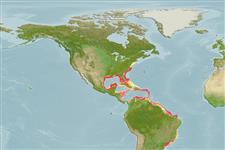Environment: milieu / climate zone / depth range / distribution range
Sinh thái học
Biển; Thuộc về nước lợ Cùng sống ở rạn san hô; Ở đại duơng, biển (Ref. 51243); Mức độ sâu 30 - 160 m (Ref. 89707). Subtropical; 40°N - 27°S, 98°W - 38°W (Ref. 5222)
Western Atlantic: North Carolina, USA (with juveniles occurring as far north as Massachusetts) to the Yucatan Peninsula, Mexico. Rare in Bermuda; one record in Cuba; also reported from eastern Brazil.
Length at first maturity / Bộ gần gũi / Khối lượng (Trọng lượng) / Age
Maturity: Lm 63.1, range 51 - ? cm
Max length : 145 cm TL con đực/không giới tính; (Ref. 40637); common length : 50.0 cm TL con đực/không giới tính; (Ref. 3708); Khối lượng cực đại được công bố: 36.5 kg (Ref. 40637); Tuổi cực đại được báo cáo: 31 các năm (Ref. 118445)
Các tia vây lưng cứng (tổng cộng): 11; Các vây lưng mềm (tổng cộng): 16-18; Tia cứng vây hậu môn 3; Tia mềm vây hậu môn: 10 - 12. Distinguished by the following characteristics: adult females and juveniles are generally brownish grey with dark vermiculations; camouflage phase has 5 dark brown saddles separated by short white bars below the dorsal fin; large males sometimes display a "black-belly" and "black-back" phase; black-belly phase is mostly pale grey, with faint dark reticulations below soft dorsal fin, belly and ventral part of the body above anal fin black, as are margin of the soft dorsal fin, central rear part of caudal fin and rear margins of pectoral and pelvic fins; depth of body contained 3.0-3.5 times in SL; head length 2.5-2.7 times in SL; convex interorbital area; angle of preopercle produced into a rounded lobe bearing enlarged serrae; posterior nostrils of adults much larger than anterior ones; smooth lateral body scales, except those covering pectoral fin (Ref. 89707).
Juveniles occur in estuaries and seagrass beds; adults are usually found offshore on rocky bottom (rarely to 152 m), occasionally inshore on rocky or grassy bottom. It is the most common grouper on rocky ledges in the eastern Gulf of Mexico. Adults are either solitary or in groups of 5 to 50 individuals; feed mainly on fishes, some crabs, shrimps, and cephalopods. Juveniles (less than 20 cm) feed mainly on crustaceans that live in shallow grass beds.
Indeterminate, multiple spawner (Ref. 86690).
Heemstra, P.C. and J.E. Randall, 1993. FAO Species Catalogue. Vol. 16. Groupers of the world (family Serranidae, subfamily Epinephelinae). An annotated and illustrated catalogue of the grouper, rockcod, hind, coral grouper and lyretail species known to date. Rome: FAO. FAO Fish. Synop. 125(16):382 p. (Ref. 5222)
IUCN Red List Status (Ref. 130435)
Threat to humans
Harmless
Human uses
Các nghề cá: tính thương mại cao; cá để chơi: đúng
Các công cụ
Special reports
Download XML
Các nguồn internet
Estimates based on models
Preferred temperature (Ref.
123201): 18.3 - 27.1, mean 23.8 °C (based on 123 cells).
Phylogenetic diversity index (Ref.
82804): PD
50 = 0.5000 [Uniqueness, from 0.5 = low to 2.0 = high].
Bayesian length-weight: a=0.00955 (0.00767 - 0.01189), b=3.04 (3.01 - 3.07), in cm total length, based on LWR estimates for this species (Ref.
93245).
Mức dinh dưỡng (Ref.
69278): 3.7 ±0.4 se; based on diet studies.
Thích nghi nhanh (Ref.
120179): Trung bình, thời gian nhân đôi của chủng quần tối thiểu là 1.4 - 4.4 năm (K=0.12-0.16; tm=3-8; tmax=16; Fec>10,000).
Prior r = 0.51, 95% CL = 0.34 - 0.77, Based on 1 stock assessment.
Fishing Vulnerability (Ref.
59153): High vulnerability (62 of 100).
Climate Vulnerability (Ref.
125649): High to very high vulnerability (73 of 100).
Nutrients (Ref.
124155): Calcium = 11.5 [6.4, 24.2] mg/100g; Iron = 0.464 [0.235, 0.829] mg/100g; Protein = 19.5 [17.6, 21.1] %; Omega3 = 0.214 [0.122, 0.378] g/100g; Selenium = 24.6 [12.6, 49.8] μg/100g; VitaminA = 38.1 [11.4, 150.0] μg/100g; Zinc = 0.57 [0.38, 0.89] mg/100g (wet weight);
